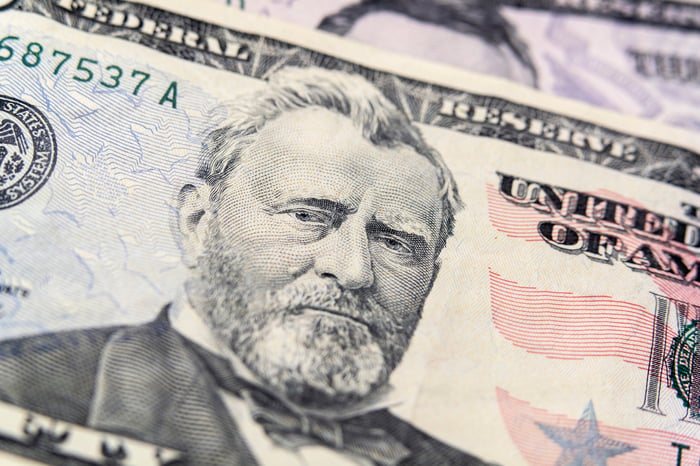It can be a tough realization for new investors and an unpleasant reminder for the tenured, but stock market corrections and bear markets are the price investors pay to take part in one of the world's greatest wealth creators, the stock market.
Last year, the ageless Dow Jones Industrial Average, benchmark S&P 500, and growth-focused Nasdaq Composite all tumbled into a bear market and produced their worst returns in 14 years. Unless you owned energy stocks or were predominantly short-selling stocks, there weren't too many places to hide from the volatility.
But there's an upside to bear markets, too. Although they can weigh on investors' emotions in the near term, the downside associated with every bear market throughout history has eventually been fully recouped by a bull market. In other words, bear markets are the ideal time for opportunistic investors to pounce on high-quality stocks trading at a discount.

Image source: Getty Images.
Best of all, most online brokerages have completely shelved minimum deposit requirements and commission fees associated with buying shares of stock on major U.S. exchanges. This means any amount of money -- even as little as $50 -- can be the perfect amount to put to work right now.
If you have $50 that's ready to invest and you won't need this money to cover any bills or emergency expenses, the following three stocks stand out as no-brainer buys right now.
Teladoc Health
The first stock that looks like a surefire buy with $50 right now is telehealth services company Teladoc Health (TDOC -0.72%).
Last year was something of a nightmare for Teladoc shareholders. After grossly overpaying to acquire applied health signals company Livongo Health in 2020, Teladoc took three separate writedowns totaling $13.4 billion. While it's good that management owned up to the fact that this premium wasn't going to be recouped, it wasn't any less painful for investors come earnings time.
But with the vast majority (or all) of these writedowns now in the rearview mirror, investors can, once again, focus on the aspects of Teladoc's business that make it an intriguing investment over the coming decade. Specifically, this is a company that's changing how personalized care is administered in the U.S. and abroad.
In situations where virtual visits are a possibility, telehealth makes patient-physician consultations far more convenient. It's an especially useful tool for physicians who want to keep closer tabs on patients with chronic illnesses. The expectation is that virtual visits will facilitate an increase in patient-physician interactions, leading to improved patient outcomes. Without question, anything that reduces the out-of-pocket expenses for health insurers is something they're going to support and promote.
Teladoc Health also has plenty of potential to turn heads with growth from membership-based services BetterHelp and Livongo. Livongo's chronic-care membership stood at nearly 1.03 million at the end of March, while the number of BetterHelp paying users jumped by 22% year over year to 467,000. Steadily increasing membership figures means more predictable operating cash flow for Teladoc.
This year is all about Teladoc Health producing cleaner income statements, continuing to grow by a double-digit percentage, and being more mindful of its cost structure. It's still early, but the company is moving in the right direction, thus far.
Lovesac
The second no-brainer stock that makes for a perfect buy with $50 is furniture retailer Lovesac (LOVE -0.52%).
Chances are that some of you went comatose when I said "furniture retailer." That's because furniture companies tend to grow very slowly, are highly cyclical, rely heavily on foot traffic into brick-and-mortar stores, and utilize the same group of wholesalers for their products. Thankfully, Lovesac doesn't fit any of these descriptors.
One way Lovesac is completely changing the game is with its furniture. Approximately 90% of the company's net sales today come from sactionals -- modular couches that can be rearranged a variety of ways to fit most living spaces. Sactionals offer a number of high-margin upgrades, such as built-in, surround-sound systems, and they come with over 200 different cover choices to fit the theme or color scheme of any home. But the biggest differentiating factor might be that the yarn used in sactionals is made entirely from recycled plastic water bottles. Lovesac's products are eco-friendly and offer abundant choice and functionality.
Another way Lovesac is outpacing its peers is with its nimble omnichannel sales platform. Although it does have a traditional brick-and-mortar retail presence in 40 states, Lovesac was able to pivot a significant portion of its sales online during the COVID-19 pandemic. These online sales, coupled with key showroom partnerships and popup showrooms, are keeping inventory at manageable levels and lowering overhead expenses. It's no secret why Lovesac was able to push into the recurring profit column well ahead of Wall Street's expectations.
The final factor that makes Lovesac a no-brainer buy is its target audience: middle-to-upper-income millennials. Consumers with higher incomes are less likely to alter their spending habits if the U.S. enters a recession or inflation picks up. This, coupled with the company's omnichannel sales platform, means Lovesac can navigate economic downturns better than traditional furniture retailers.

Image source: Getty Images.
Sirius XM Holdings
The third no-brainer stock to buy with $50 right now is satellite-radio operator Sirius XM Holdings (SIRI).
Sirius XM's biggest hurdle is the growing likelihood that the U.S. will enter a recession. With the Fed now modeling a mild recession into its outlook for later this year, there's the expectation that advertising revenue will drop off. Ad revenue tends to be an important sales driver for radio operators.
There's also some concern about auto sales slowing. The auto industry is highly cyclical, and Sirius XM counts on converting promotional subscriptions with newly sold vehicles into self-pay subscribers. If fewer new cars are sold, the assumption is that self-pay subscription growth will slow.
But in spite of these near-term headwinds, Sirius XM has a number of competitive advantages up its sleeve. Topping the list is Sirius XM's revenue stream.
As noted, the vast majority of terrestrial and online radio operators rely on advertising revenue to fuel their businesses. This works out just fine until there's a recession. Sirius XM generated just 17.5% of its first-quarter net sales from advertising -- and this came primarily from its ownership of Pandora. By comparison, 78.9% of net sales come from subscriptions. Subscription revenue is far stickier than ad sales. In other words, subscribers are less likely to cancel when economic turbulence occurs than advertisers are to pare back their spending. This puts Sirius XM in the driver's seat during any economic turmoil, relative to its peers.
Additionally, Sirius XM is a legal monopoly in the satellite-radio space. While it does still face some degree of competition from terrestrial and online radio operators, its status as a legal monopoly helps it pass along price hikes to its 32 million self-pay subscribers.
Investors can also take solace in Sirius XM's cost structure. Whereas some line items, such as revenue share and royalties, can jump around from quarter to quarter, a number of expenses, such as transmission and equipment costs, are more or less fixed. This means Sirius XM's operating margin can improve over time as it steadily builds its subscriber base.





